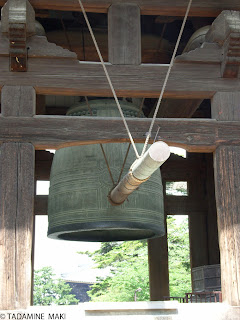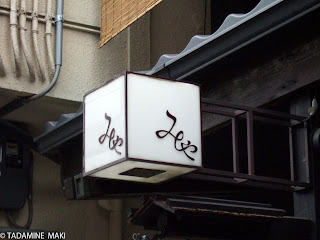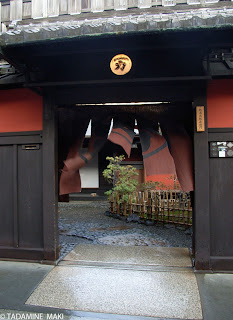Kyoto Daily Photo
This blog is a collection of the photos, showing the daily beauty in Kyoto.
Tuesday, July 31, 2007
Monday, July 30, 2007
Sunday, July 29, 2007
Saturday, July 28, 2007
Friday, July 27, 2007
Wednesday, July 25, 2007
Tuesday, July 24, 2007
Wagashi, a Japanese sweet


These bigger ones are called Rakugan, dried sweets and made of powered rice and sugar, are about the size of the thumbnail. The smaller ones with star shape are called Kompeito, made of sugar.
Such traditional Japanese sweets, Wagashi, are different in motif up to the season. Now it is summer. The star-shaped sweets are the combination of purple and light blue, and white and express the flowing water and feel refreshingly cool. In the water, made of sugar sweets, goldfish are swimming, fresh leaves are floating and morning glories are flowering. They, goldfish, fresh leaves and morning glory, reminds us of the pleasant and sweet side of summer.
In this way, we enjoy such traditional sweets with our eyes and mouths.
Monday, July 23, 2007
Netsuke, a small toggle made of wood or ivory



These are netsukes. A netsuke is a form of miniature sculpture for men's kimonos, made of wood, ivory, shell and more, and serves both functional and aesthetic purposes.
The kimono, the traditional Japanese dress, had no pockets and men suspended their cigarette pouches, pipes, inro(see the previous post) and more on a silk cord from their obi (kimono sash). A small toggle was attached to stop the cord from slipping through the obi. The toggle is called a netsuke.
The netsuke had been popular during Edo era, from 1603-1867. But today I have not seen any men using it because we don't usually wear kimono. Some people collect them now in Japan as artworks. But Netsuke seems more popular in US or other countries than in Japan.
Sunday, July 22, 2007
Inro, a case for holding small objects

This is Inro, a small case, the same as cigarette pack in size, made of wooden, coated with urushi lacquer, decorated and drawn with gold powder, for holding small object, such as seal, ink pad, medicines and more. As the years rolled by, some people, especially some high ranking samurais, had collected the cases as accessories.
Saturday, July 21, 2007
Friday, July 20, 2007
Thursday, July 19, 2007
Wednesday, July 18, 2007
Tuesday, July 17, 2007
Tofu

These are called Tofu, made of soy bean, and are sold in supermarkets. Tofu, roughly speaking, has two kinds: Momen and Kinugoshi Tofu.
Momen feel a little rough touch and Kinugoshi feel a soft and silky touch and I prefer Kinugoshi.
Momen has less water than Kinugoshi but contains more protein, calcium, iron(Fe). Kinugoshi, on the other hand, contains more kalium and vitamin B1.
I often use Kinugoshi for cooking miso soup, Yudofu or boiled tofu, some Chinese cuisine. When I go to supermarket in the late evening, Kinugoshi is often sold out, though Momen is still left. Kinugoshi seems to be more popular than Momen in Tokyo.
Monday, July 16, 2007
Japanese architecture, Toji Temple

This photo is a part of main building in Toji Temple, Kyoto. Each part, tile roofs, rafters, wooden blocks supporting the rafters, cross members on the pillars and pillars, is combined with in a balanced manner. Japanese architecture tends to have less decoration so the well balance is vital to the its aesthetic. The equilibrium of the parts is one of points of views in Japanese old architecture.
Sunday, July 15, 2007
Saturday, July 14, 2007
Friday, July 13, 2007
Thursday, July 12, 2007
Fresh green of maple leaves, near Kozanji Temple
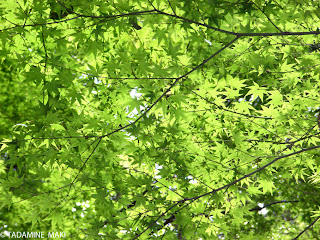
The sunray makes the fresh green of maple leaves more vivid and the freshness quite show us the bright side of life.
The maple leaves are just as the same as baby's hand in size. They are rather thinner so we can see the leaf veins through the sunlight very clearly. They are adorable and the leaves themselves look like artworks.
Wednesday, July 11, 2007
Arched bamboos close to the wooden outer wall, Gion, Kyoto
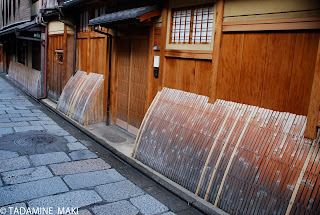
When we wandering around the middle of Kyoto, our eyes are often met by such arched bamboos, installed at the space under the eaves of wooden houses and restaurants.
Some say that the bamboos are made and put to prevent the outer wall from getting dirty and hurt. Without them, it will be likely that some animals do "the natural water works" towards the wooden outer wall (they seem to need some "target", like wall or pole) and that raindrops from the edge of the eaves drop on the ground so that the water splash on the wall. So the wall would be more likely to get hurt.
But they have another purpose. They are made for keeping strangers from hearing what people inside the wall of restaurant say. The wall allows sounds to pass through easily because the wall is thin and made of wooden. Plus, such houses and restaurants are very close to public road. Without them, we can easily hear what people say inside. In those days, some guests used to do secret talk at such wooden restaurant. The bamboos can make strangers keep away from the wall.
Kyoto has been rich in wooden traditional houses and the photo is typical scenery in Kyoto.
Tuesday, July 10, 2007
Pickled vegetables, Kyoto

At the storefront are put some vegetables on the baskets. Something like clay or sand sticks to the vegetables. What is that?
It is neither clay nor sand, but is called Nuka, powdered rice bran produced from the outer coat of rice. It is rich in Vitamin B and lactic acid bacterium, produced by the slightly watered rice bran, make the juicy vegetables tasty after they are pickled in the pasted rice bran with some salt and a few pieces of red pepper, for a certain time. We usually use cucumber, eggplant, Chinese cabbage and more for pickling.
Every home used to have an earthenware pot or plastic box, full of the paste for pickling, till some decades ago. Now some still have the pot or box but the others usually buy the pickled vegetable at vegetable shops or supermarkets. We eat them with some drop of soy sauce and they are musts for traditional breakfast, consisting of boiled rice, miso soup, fermented soybeans (natto in Japanese) and grilled fish.
I prefer the Chinese cabbage one with some drop of soy sauce and powdered hot pepper.
Monday, July 09, 2007
Sunday, July 08, 2007
Small is beautiful!!

These little name plates are hang on the outer wall just beside the entrance of Okiya, a place to send Maiko or Geisha to Ochaya just during parties. Ochaya is a traditional restaurant, serving elegant cuisine, where guests sit on tatami mat and enjoy dining, drinking, chatting with Maiko or Geisha and watching them dancing and playing some music with some instrument.
By the way, each name on the plates is Maikos' and Geishas', who belong to this Okiya. Nick names for working are to be given to each Maiko or Geisha. Its name consists of two or three Chinese letters, as is shown on the photo and the photo shows that all the names has the same one character. The character has been passed on to the names of younger Maikos at the Okiya, like other Okiyas.
This Okiya have passes on the letter, Ko, 小, meaning small or petite. The letter is well suited to the cuteness of Maiko. Plus, Mame, 豆, is often used for the name of Maikos, too. Mame originally means beam but also have a meaning of "little" or "petite".
Japanese seems to prefer the smaller to the larger. Small is beautiful!
Saturday, July 07, 2007
Cedar trees, Kyoto

This photo was taken in Kitayama, the northern part of Kyoto city. This area is famous for Japanese cedar, supplying for wooden buildings. Cedar is easy to cut and has beautiful grains, so the material has been used for buildings very much. Some of the cedar from this area are polished with sand and some water, used for the pillar of an main alcove in guest rooms, Tokonoma in Japanese.
Friday, July 06, 2007
Sushi part3
The recommendation set course, Osusume set in Japanese, at a sushi restaurant in Tokyo, contains 12 pieces of sushi and chefs cook them in order. The order and kinds of sushi change up to shops and seasons. At this shop, the first is a small squared piece of rolled egg, the second is chu-toro, the third is mako-garei and ..., the eighth is white little shrimp. (See yesterday's and the day before yesterday's post.)
Now, let's continue where we left off!
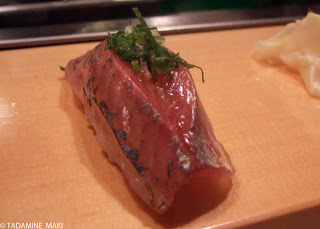
The ninth is horse mackerel, Aji in Japanese and one of typical Hikarimono, as well as mackerel, Saba in Japanese. Hikarimono is a group of fish, whose surfaces are glittering. Spring to summer is best season for Aji and fatty in these seasons. This fish is also good with ponzu, soy sauce with vinegar and citrus juice.

The tenth are "cut sushi roll", norimaki in Japanese. The rolls on this photo have two kinds: tuna roll and sliced squid, salted cod egg, Mentaiko in Japanese, and cucumber roll. The style of sushi, norimaki, is easier to cook than any other sushis on other photos. So we sometimes cook them by ourselves at house parties.

The eleventh is sea eel, or conger, Anago in Japanese. Its taste and appearance look like eel very much. But it is less fat and softer than eel. The sauce on the sushi is slightly sweet than soy sauce and goes well with the fish. This fish contains rich Vitamin A, as well as eel, and better for summer fatigue in Japan.
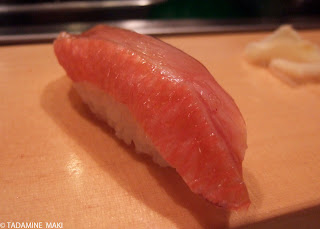
The last one is alfonsino, Kinme-dai in Japanese, a kind of red sea bream. This fish in the shop is tasted with kelp. It is fatty and yummy. Unlike this case, the fish is usually cooked by boiling with soy sauce, sugar, Japanese Sake and salt, added slice ginger on it.
Oh, I am full!! How much?
It is about 4,000 yen and rather reasonable for these quality.
Anyway, eating is believing!!
Let's have a try!
Thursday, July 05, 2007
Sushi part2
The recommendation set course, Osusume set in Japanese, at a sushi restaurant in Tokyo, contains 12 pieces of sushi and chefs cook them in order. The order and kinds of sushi change up to shops and seasons. At this shop, the first is a small squared piece of rolled egg, the second is chu-toro, the third is mako-garei and the fourth is Uni.(See the previous post.)
Now, let's continue where we left off!
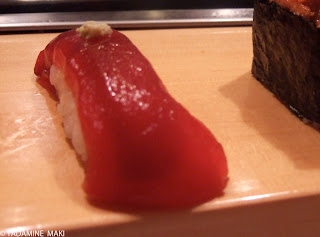
The fifth is Zuke, soaked red tuna in the mixture of sake and soy sauce about 30 minutes. Zuke is a kind of tuna, just like chu-toro, but less fat and more salty than chu-toro. In those days, Zuke was more popular than chu-toro, medium fatty tuna, otoro, high fatty tuna. But now chu-toro and otoro is more popular.
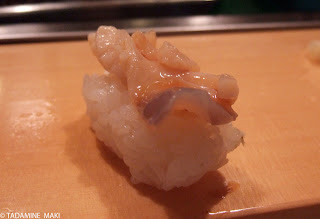
The sixth is Miru-gai, a kind of shell. Any course menus at sushi bars usually contain a piece of shell sushi. This shell is very popular one, along with Red shell, Akagai in Japanese. This shell of the shop feels a softer touch than usual and so fresh to dance on rice!! I wish I could take the movie of this dancing shell.

The seventh is Mekajiki, or Kajiki-maguro. This is said to be a kind of tuna but lower fat than red tuna so very healthy. The fish is now, during June to August, in season. This goes well with not soy sauce itself but soy sauce added with vinegar and citrus juice.

The eighth is white little shrimp, Shiro-ebi in Japanese. On the rice are put many little shrimps. This is creamy, succulent and a little sweeter than normal shrimp.
Oh, it is time to finish and the rest is tomorrow...
Wednesday, July 04, 2007
Sushi part1
I have an excuse. These photos were not taken in Kyoto but in Tokyo. I uploaded these photos because Kyoto has been the capital of the traditional Japanese culture and Sushi is also the typical traditional Japanese cusine, though sushi is more popular in Tokyo than in Kyoto.
Anyway, I will add a small comment on each of 12 pieces of sushi in the Omakase, meaning 'recommendation', set menu at Sushi Dai,(here is the photo of the restaurant). The menu partly changes up to the seasons because the fish we can catch and eat differs with the season.
Well, the first sushi in this menu is a small piece of rolled egg and no vinegared rice ball. Unfortunately, there is no photo. Excuse me! The egg might be added with sugar, salt and perhaps sweet cooking rice wine, Mirin in Japanese. By the way, some epicureans says that if the egg served at a sushi restaurant is delicious, most of the restaurants are better. So the egg is thought to be a sort of important item for making a decision whether or not the sushi bar is better before they eat all the pieces of sushi. The egg seems just like butter added by bread in French restaurant or grissini in Italian restaurant.

The second sushi is Chu-toro, medium fatty tuna, which is the queen of the sushi and one of the most popular of all sushi items. This is not too rich but succulent.
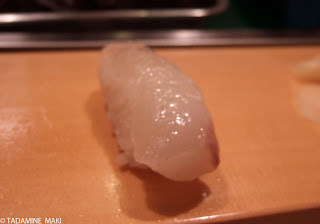
The third is Mako-garei in Japanese, just like flounder, or flatfish, Hirame in Japanese. Hirame might be rather familiar to European people. The fish is one of the most popular fish with white flesh. At this bar, on the sliced flatfish are added a small amount of rock salt from Bolivia and a drop of juice from some citrus fruit. This fish is little fat and goes well with the salt and citrus juice very much.

The fourth is Uni, sea egg. The one at the bar is more creamy and sweeter than usual and rather red. This red Uni is, I suppose, called Ezobasun-Uni and one of first grade Unis, and we can eat it from spring to summer. We usually eat the orange one more than the red because the red one is precious and rare.
The rest is tomorrow...
Tuesday, July 03, 2007
Monday, July 02, 2007
An artwork of calligraphy

This calligraphy is a work of Ryokan, one of greatest poets in Edo era, 1603 to 1867. The letters were written in a very unique way and far from the ones that we can read today. So most of us cannot read these letters. If people who don't know Japanese letters see the work, then they may take it for Arabic characters.
A set of the letters seems to be not only a tool to pass on idea, feeling and information, but also a tool to express the beauty and feeling that can be expressed by the words. I feel as if the line and curve of this work express his pure mind, far from vanity, though I cannot totally understand what the work says. How do you feel, seeing this work?
Sunday, July 01, 2007
Theme Day for the month of July: The Color Red, Japanese seal
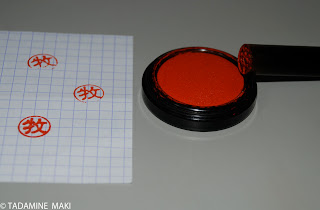
This is my seal and more used by the identification than the signature in Japan. We use it to register bank account, draw up a contract, approve a document and more. Ivory had been popular for its material, but now plastic is replacing it and ebony wood and rosewood is popular.
Many other city daily photo blogs participate in this theme day today, why don't you pay them a visit? Remember, due to time difference they might not all be ready when you visit them.
Shanghai, China - Mumbai, India - New York City (NY), USA - Manila, Philippines - Albuquerque (NM), USA - Hamburg, Germany - Stayton (OR), USA - Los Angeles (CA), USA - Hyde, UK - Oslo, Norway - Brookville (OH), USA - Melbourne, Australia - Stavanger, Norway - Bellefonte (PA), USA - Bucaramanga (Santander), Colombia - Joplin (MO), USA - Singapore, Singapore - Selma (AL), USA - Cleveland (OH), USA - Kuala Lumpur, Malaysia - Chandler (AZ), USA - Stockholm, Sweden - Seattle (WA), USA - Boston (MA), USA - Arradon, France - Evry, France - Baton Rouge (LA), USA - Maple Ridge (BC), Canada - Boston (MA), USA - Grenoble, France - Cottage Grove (MN), USA - Greenville (SC), USA - Hilo (HI), USA - Nelson, New Zealand - La Antigua, Guatemala - Brisbane (QLD), Australia - Singapore, Singapore - Tel Aviv, Israel - Hong Kong, China - Sequim (WA), USA - Paderborn, Germany - Saarbrücken, Germany - Rotterdam, Netherlands - Tenerife, Spain - Kyoto, Japan - Tokyo, Japan - Sydney, Australia - Naples (FL), USA - Cologne (NRW), Germany - Wassenaar (ZH), Netherlands - Saint Louis (MO), USA - Cypress (TX), USA - Ocean Township (NJ), USA - Mainz, Germany - Toruń, Poland - Menton, France - Monte Carlo, Monaco - Singapore, Singapore - North Bay (ON), Canada - Jakarta, Indonesia - Montréal (QC), Canada - Tuzla, Bosnia and Herzegovina - Minneapolis (MN), USA - Baziège, France - San Diego (CA), USA - Prague, Czech Republic - Ampang (Selangor), Malaysia - New York (NY), USA - Kajang (Selangor), Malaysia - Sharon (CT), USA - Newcastle (NSW), Australia - Port Angeles (WA), USA - Nottingham, UK - Villigen, Switzerland - Chicago (IL), USA - Torquay, UK - Brussels, Belgium - San Diego (CA), USA - Mexico (DF), Mexico - Saint Paul (MN), USA - Cape Town, South Africa - Paris, France - Seoul, Korea - Manila, Philippines - Milano, Italy - Chennai (Tamil Nadu), India - Austin (TX), USA - Chennai, India - Madrid, Spain - Seoul, South Korea - Wailea (HI), USA - Toronto (ON), Canada - Ajaccio, France - Buenos Aires, Argentina - Silver Spring (MD), USA - Zurich, Switzerland - Sydney, Australia
